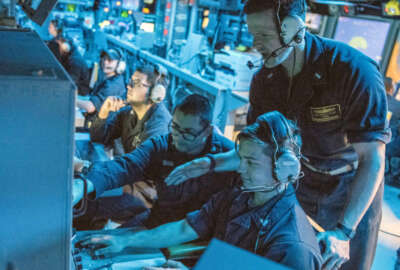
This researcher is discovering what the Navy can learn from sharks
Navy planners believe unmanned, underwater vessels will eventually become an important component. Now an associate at the Naval Research Laboratory is close to a...
Best listening experience is on Chrome, Firefox or Safari. Subscribe to Federal Drive’s daily audio interviews on Apple Podcasts or PodcastOne.
Navy planners believe unmanned, underwater vessels will eventually become an important component in operations. Now an associate at the Naval Research Laboratory is close to a breakthrough in a crucial part of future vehicles, their external surfaces. With more on the research and why it’s important, research associate Nicole Xu and her NRL mentor Jason Geder, joined Federal Drive with Tom Temin.
Interview transcript:
Tom Temin: Dr. Xu, good to have you on.
Dr. Nicole Xu: Thank you for having me this morning.
Tom Temin: And her NRL mentor, engineer Jason Geder. Mr. Geder, good to have you on.
Jason Geder: Thank you for having me.
Tom Temin: Nicole, let’s start with you. What is it you’re actually looking at here as a researcher? And is it in the field of electronics mechanics, fluid dynamics, set the scene here for us?
Dr. Nicole Xu: Yeah, all of those things. Basically, the premise of this current work is to create sharkskin inspired surfaces for turbulent drag reduction of unpiloted underwater vehicles, or UVs. So to take a step back first, more broadly, animals have evolved for over hundreds of millions of years, and they tell me how missionary pressures. So you can say that they’re really locally optimized for real life constraints, which is very similar to how we as scientists can address engineering problems. So when we take a problem, like how do we create more energy efficient vehicles, we can really look to nature for inspiration to do some of that major legwork for us. And then we can take the best of both natural and artificial design and really run with ideas like building bioinspired, sharp denticles surfaces,
Tom Temin: Well tell us what that is actually – what is it about a shark skin and denticles that apply here.?
Dr. Nicole Xu: So what that means is that sharks have micro structures on their skin called denticles, which look like small teeth or reptile scales. And this trait has been shown to improve things like speed, energy efficiency, stealth and antifouling properties so that they can stay so fresh and so clean. But we’d really like to take advantage of these existing properties to create artificial sharkskin denticle inspired surfaces that we can then apply on UUVs to improve the overall performance of underwater vehicles. And it can really seem counterintuitive that adding these micro-structures can actually improve the hydrodynamics. But you can think of it like how the dimples on a golf ball improve its aerodynamics, less drag, more lift, more backspin. And that’s essentially what we’re trying to do in the process of testing by adding shark’s fin like textures. So what are the best design features looking from real sharks and previous research in this field, and how can we apply them to underwater vehicles? So this is a part of a greater line of work with bioinspired designs and UUVs at NRL.
Tom Temin: And Jason, the sounds like it’s both a design and also at some point a manufacturing challenge.
Jason Geder: Yes, absolutely. Nicole has been working with different manufacturing processes to figure out what the best materials are for some of her designs. Luckily, at the Naval Research Lab, we have some great facilities for additive manufacturing, and Nicole’s been able to leverage that for some of her early work on her research.
Tom Temin: And how do you envision making such a denticle skin, let’s call it, a reality? What are some of the promising things you’re looking at? Nicole?
Dr. Nicole Xu: Currently, I’m testing various shark’s denticle inspired designs using additive manufacturing techniques. So taking inspiration from real natural shark denticles and previous research, we’ve created this CAD, or computer aided design, that we can then print using various state of the art 3d printers at NRL. And we can test parameters like identical sizes, spacings, and materials from rigid plastics to flexible elastomers. And it’s been really interesting exploring the various capabilities because it’s often a trade off with resolution and the size of the prints so we can get something that is very high quality, high resolution in terms of the prints, but it’s limited to an area in size of a business card or smaller, but we can choose to reduce that resolution for a larger print like with a base foil. So what I’m currently working on and moving into the next steps are testing these 3D printed surfaces onto hydrofoils. So think something that looks like an airplane wing or a fish body. And once we can show improve performance using lift, drag, thrust, power consumption and other metrics, we can then take the most viable candidates for integration onto UUVs, like fish inspired robots, like the Wanda vehicle or other undersea gliders.
Tom Temin: We’re speaking with Dr. Nicole Xu, she’s a research fellow with the Laboratories for Computational Physics and Fluid Dynamics at the Naval Research Laboratory. And with her mentor, Jason Geder is an engineer at the NLR. And let me ask you this, Jason, it sounds like potentially this could have very wide ranging application beyond the smaller unmanned underwater vehicles for the Navy.
Jason Geder: Yes, I think that’s right. Our focus in the laboratories for computational physics and fluid dynamics at NRL has been primarily on small underwater vehicles. We’ve focused a lot of our vehicle research on bioinspired propulsion and control mechanisms, but we haven’t considered altering some of the surface properties in roughness as Nicole’s discussing here. So we’re excited about the work that she’s doing. In addition to the potential for drag reduction and energy savings, we’re also going to be looking at how these denticles could provide enhanced thrust production when they’re placed on the actuated body or fins surfaces that we’re looking at. But to your question about larger systems, I think that that has been shown in previous literature that this can provide benefits at all scales, but it’s not one of our primary focuses at NRL right now.
Tom Temin: Well, yeah, it’s early. But I mean, you could almost imagine this on airplanes, surfaces and ship holes and so forth, if anything, I mean, that’s the essential challenge for the Navy is better, more efficient flight and motion through water and underwater, correct?
Jason Geder: Absolutely. That is correct. This has wide ranging applications, and I know Nicole’s excited to see what her results prove out and where her research can go from here.
Tom Temin: And Nicole, I wanted to ask you of all of the studies and fields you could have pursued, judging from a pretty impressive resume and as a young woman leading the way in STEM, which is always something people are seeking nowadays, what made you choose naval dynamics and Naval Research as something you wanted to pursue?
Dr. Nicole Xu: My background is in bioinspired robotics. So in the past, in my PhD, I focused on aquatic invertebrates like jellyfish pipe previously created a biohybrid robotic jellyfish by integrating a micro electronic structure onto a live animal. And we chose jellyfish because of their energy efficiency, but each model organism has its pros and cons for bioinspired design. So while jellyfish are incredibly energy efficient, literally the most energy efficient animal in the world, other animals like sharks offer different advantages such as speed and antifouling, as well as, as well as energy efficiency compared to robots.
Tom Temin: But it sounds like this work you’re doing now brings together a lot of issues besides fuel efficiency, which is, I guess, a strategic issue more than necessarily a green issue for the Navy, but also stealth, because the ability to move through water undetected is crucial. And of course, speed is always an advantage.
Dr. Nicole Xu: Yes, it does have applications for stealth. So sharks naturally rely on stealth and hunting behaviors to survive. So the hope is that artificial shark skin surfaces can also decrease noise signatures and vehicle wakes, which would then make these vehicles stealthier but also minimize potential disturbances to the environment from a civilian perspective on ocean monitoring. So while it’s true that this has the potential to improve stealth and underwater vehicles, it’s also true that this has the potential to increase speed, thrust overall efficiency and antifouling with broader applications for both the Navy and civilian purposes.
Tom Temin: And to doing the research then, without having built quantities of the material, it sounds like you are doing a digital approach to testing the theory of how identical surface or shark type skin moves through fluid.
Dr. Nicole Xu: It is a very experimental approach. But as Jason mentioned, were part of the laboratories for computational physics and fluid dynamics. So we are hoping to incorporate a lot of different applications and potential perspectives onto this research, including computational fluid dynamics to visualize what are the fluid flows. And it’s really this combination of using theoretical models as well as experimental work that’s going to move us forward.
Tom Temin: So you look at screens and have your hands in water testing surfaces both. Absolutely both are fun. And Jason, we should be happy that we have someone working for the Naval Research Laboratory that is concerned with really well developed organisms that bite and sting.
Jason Geder: Yes, whenever we look at postdoctoral research candidates are always looking to expand the expertise and fill capability gaps within our laboratories for computational physics, but also across NRL as a whole. And Nicole had a very strong background working with bioinspired systems and she brings a new expertise and an interest in expanding our experimental design and fluid dynamics capabilities. So it’s wonderful having her as part of the team.
Tom Temin: Alright. Jason Geder is an engineer and engineering mentor at the Naval Research Laboratory. Thanks so much for joining us.
Jason Geder: Thank you for having me.
Tom Temin: And Dr. Nicole Xu is a research fellow at the Laboratories for computational physics and fluid dynamics at NRL. Great speaking with you.
Dr. Nicole Xu: Thanks so much, thank you for having me.
Copyright © 2025 Federal News Network. All rights reserved. This website is not intended for users located within the European Economic Area.
Tom Temin is host of the Federal Drive and has been providing insight on federal technology and management issues for more than 30 years.
Follow @tteminWFED





